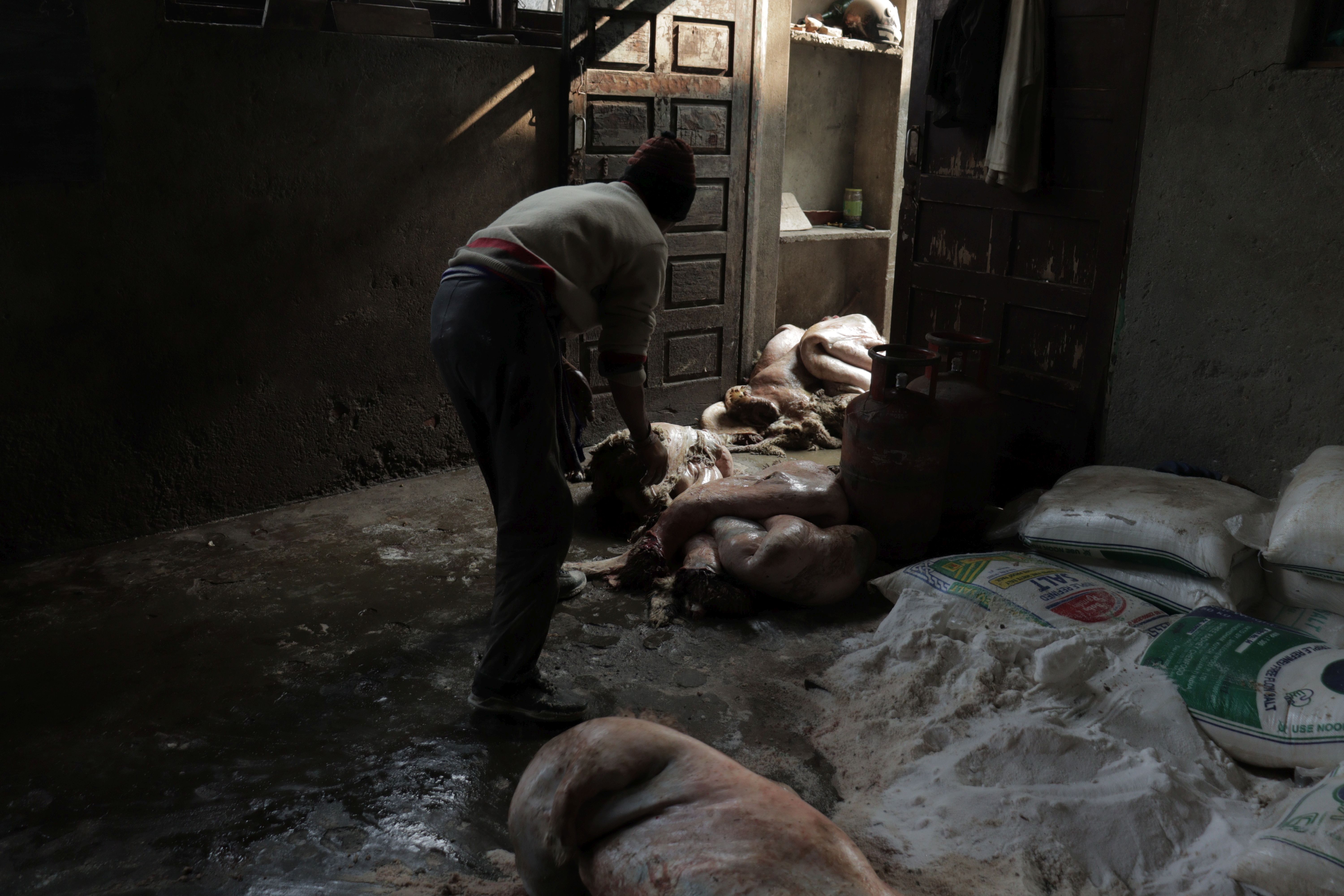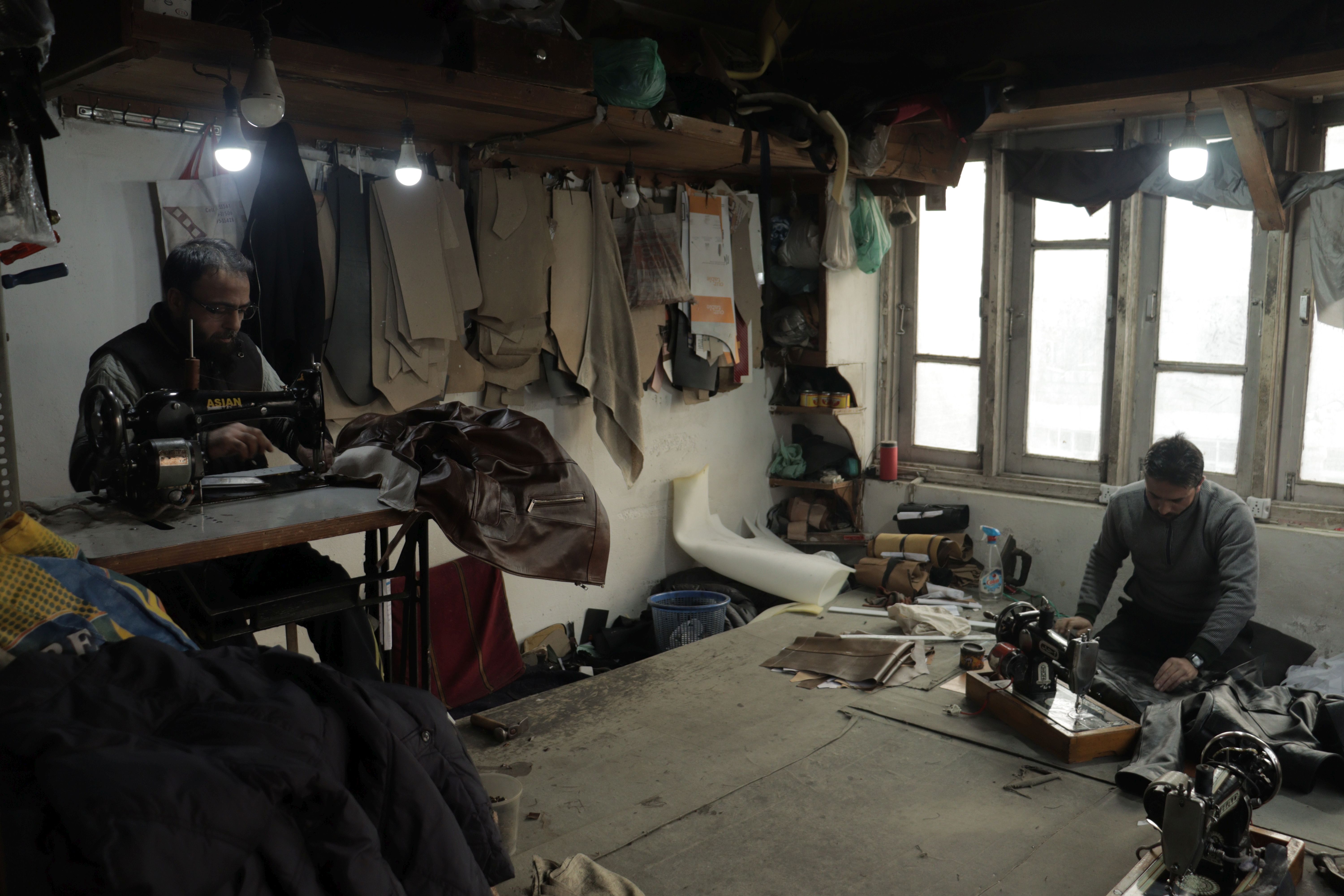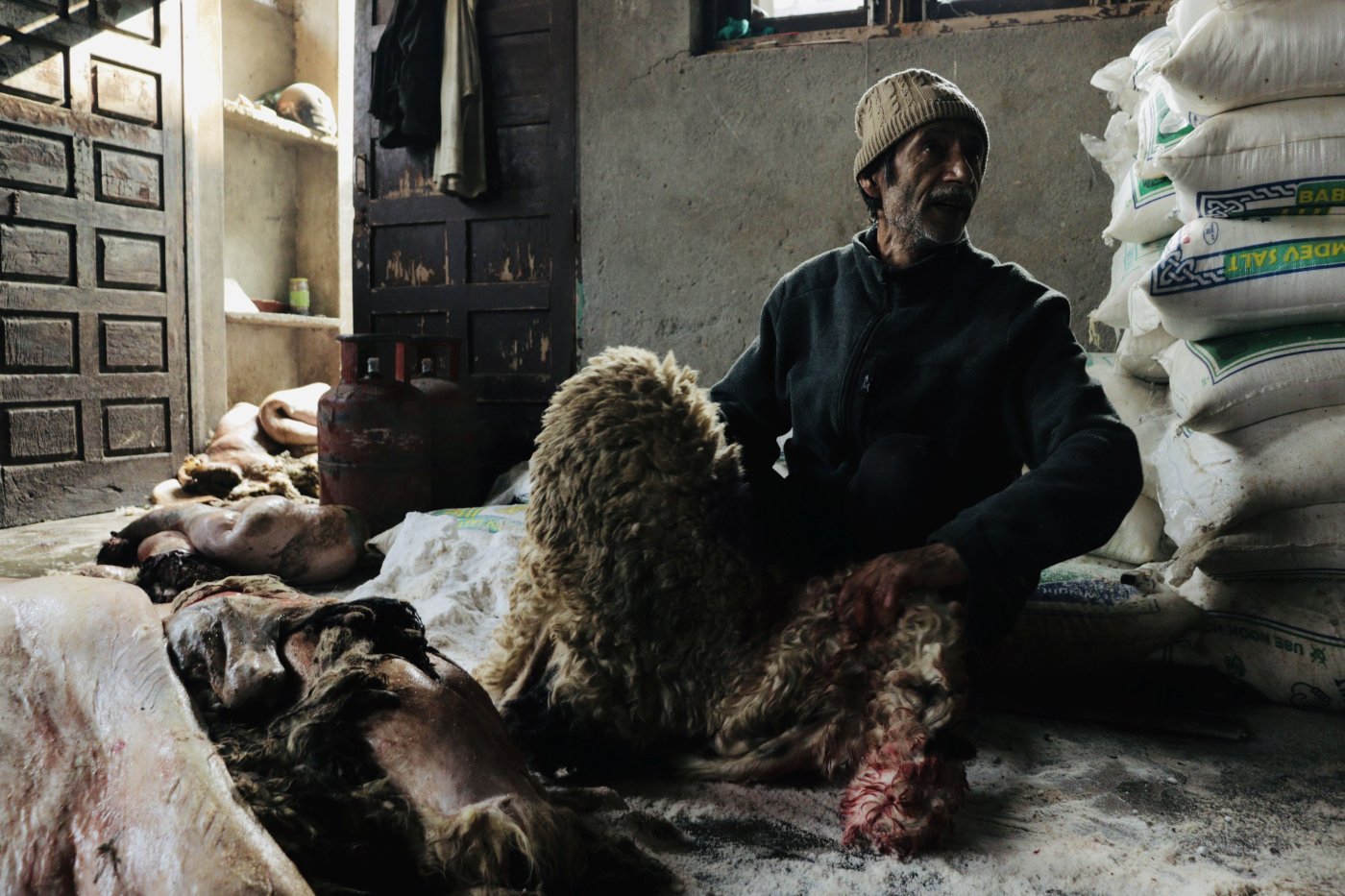Srinagar: For 10 years, Inayat Hussain's father ran a flourishing small-scale leather business in Srinagar, transporting raw hide to leather goods manufacturing hubs such as Jalandhar in Punjab and Kanpur in Uttar Pradesh. Then, the young Hussain recalled, from 2014 onwards, a gradual decline began, picking up pace over the next couple of years as Hindu vigilantes stopped trucks carrying meat and rawhides in various parts of India.
Hussain, 25, recalled how the delivery of leather consignments to Jalandhar where raw leather was crafted into bags, jackets and shoes were held up by cow vigilantes on several occasions in 2015. (See here, here and here.)
He returned home from a nearby market one day that year to find everybody at home anxious, desperately making phone calls.
“I got to know that the truck that was carrying our unfinished leather for transportation to Jalandhar was stopped in Haryana by cow vigilantes,” he said. “The truck driver was beaten up badly and had run away into a village.”
Three days passed before the family was able to establish contact with the driver. All the material was damaged. “There was a sense of fear,” Hussain said, recounting the reports of similar incidents that came to their notice subsequently. “We stopped transporting leather. It was the beginning of the end.”
Inaam Hussain wound up his leather business entirely in 2015-16. Not long after, his health began to deteriorate and he was diagnosed with kidney disease. Their financial condition, already strained, was weighed down by the medical expenses. “It was saddening,” Hussain said. His father eventually passed away in 2022.
Hussain’s family business was one of hundreds that were hit across the country by state governments’ bans on the slaughter and transportation of cows around 2017 and the preceding attacks by cow vigilantes, sometimes involving theft, arson and assaults.
The leather industry is facing the death knell at a time when unemployment in Kashmir is soaring—third highest in the country in March 2023.
Article 14 has reported that the unemployment crisis worsened after Article 370 was abrogated in August 2019, with the five-month security lockdown and frequent Internet shutdowns devastating businesses. A July 2020 study by the Kashmir Chamber of Commerce and Industries (KCCI) estimated that Kashmir’s economy faced a loss of Rs 40,000 crore due to the shutdowns, losses exacerbated by the subsequent global pandemic.
According to the All Kashmir Raw Skin Dealers Association, animal hide traders in the valley experienced a 90% decline in business since 2014.
The association could not estimate how many traders operated in Kashmir, but said they had been engaged in the rawhide business for generations, mostly based in the downtown area of Srinagar. They collected hides of sheep, goat, cow and other animals from different places in Kashmir and transported these to various Indian cities and to leather makers in Kashmir. The Jammu and Kashmir Entrepreneurship Development Institute, Srinagar, estimated in 2016 that the region had the potential to generate Rs 600 crore annually from the rawhide industry.
Kashmir’s director for handicrafts and handlooms, Mahmood Ahmad Shah, did not respond to Article 14’s request for a comment on the rapid decline of the leather industry in the region.
A Father Struggles To Keep His Family Afloat
Mohammad Shafi, 32, from Anantnag district in south Kashmir, has reeled under acute financial distress for months.
Shafi used to collect the skin of sheep and cows for his leather trade. Their multi-generational business began to sink a few years ago. “The market price of hides used to be around Rs 1,200-Rs 1,300, now it has gone down to Rs 100, that too for a clean piece without any damage,” said Shafi.
He said 90% of the hides in Kashmir go waste because there are no takers in the domestic market. Traders had maintained connections for decades with factories in Jalandhar and Kanpur, which themselves have been forced to close down in recent years.
For the past year, Shafi has not been able to pay the school fees of his three children though he has kept the business running.
He said traders now have to wait three to four months to receive payments for hides they sell. There is still a demand in the international market for cow hides but following the bans by several state governments on cow slaughter, domestic traders have been unable to cash in on that demand. “We literally have to throw most of our stock to the dogs because they just pile up, as nobody takes them,” he said.
Shafi’s father had brought him into the family business when he turned 18. The family has been in the business for two decades, but Shafi has begun to feel it might be wiser to shut shop. “It’s already dead, but what else should I do?” Shafi asked. He said he has neither the training nor the money to start up a new trade.
His children’s school has sent notices about clearing his dues, warning him that they may be forced to stop the children from attending classes. He also has a nine-month-old toddler who has been unwell. “I’m hoping it’s nothing major, because then how would I pay for her treatment?”
The Quick Decline Of A Centuries-Old Legacy
Kashmir’s leather industry dates back to at least the Mughal period during which rulers' active support in promoting the region's arts and crafts saw Kashmiri leather workers gain fame for their exquisite leather items including shoes, boots, bags and belts. The leather industry of Kashmir was primarily concentrated in the old city of Srinagar, capital of the erstwhile Mughal province of Kashmir.
Leather work flourished in the valley on account of a thriving large-scale leather trade. The climate of Kashmir offered ideal conditions for producing fine hides with a grainy texture with minimal risk of scratches.

Leather products from Kashmir were also sought after in Europe, with the earliest restrictions on leather trade implemented during the rule of Maharaja Pratap Singh, who banned the sale of skins and horns.
The Kashmiri leather industry primarily used goat, cow and sheep skin, tanned using a combination of vegetable and mineral substances. The craftsmanship involved embellishments with intricate designs and patterns, using embroidery, carving and inlay work.
During the 1990s, the leather industry in Kashmir encountered numerous difficulties stemming from political unrest that led to a decline in the number of outside buyers visiting Jammu and Kashmir for purchasing tanned hides. This disruption severely impacted production and trade, ultimately resulting in the closure of one of the two tanneries located in Lassipora in south Kashmir’s Pulwama district.
Sheikh Manzoor, a member of All Kashmir Raw Skin Dealers Association, Srinagar, came into the leather business in 1996, and started accumulating hides of cows and sheep. He sold these to outside dealers and also processed some leather in Kashmir. Manzoor was in the leather business for over 20 years.
His business prospects changed dramatically from September 2014 onwards, he said. Some of his colleagues had to sell their houses to repay business loans they had taken. “I lost every penny I had earned.”
Manzoor recalled that buyers, upon realising the effects of the vigilante incidents, stopped buying leather from Kashmir. “They became apprehensive about other bans that might follow,” he said.
The incidents involving cow vigilantes in other parts of the country led to the closure of business for most of the small-scale leather makers of the valley. “Once we lost contact with the buyers, it was difficult for us to build trust with them again.,” Manzoor said. “It was never regained, not to this day.”
Declining Trade Despite Rich Source Of Raw Material
Currently, there are six functioning leather tanneries in Kashmir. Hides and skin are the basic raw material for the region’s leather industry which supplies these to various leather goods-manufacturing hubs in the country including Amritsar, Ludhiana and Chennai.
The leather industry employed thousands of workers. In 2008, more than 35,000 cow hides and more than 2 lakh sheep and goat hides were exported to various cities of India from Kashmir. Empirical data for the present was unavailable, but the All Kashmir Raw Skin Dealers Association said the 90% decline in the industry included employment and turnover.
By some estimates, more than 3 million sheep and cattle hides were available in Kashmir annually in 2013.
According to data from the sheep husbandry department in Kashmir, around 2.2 million sheep are slaughtered in Kashmir every year—roughly about 2,10,00,000 kg of meat consumed—and the remaining are cattle. The raw material exported to the different parts of the state when sold, the cost of the finished form of leather becomes very expensive.
According to various mutton dealers in Kashmir, more than 2 million sheep hides are available for transportation annually.
In Kashmir, leather is produced in a semi-finished state using traditional techniques that do not rely on heavy machinery or advanced technology. Owner of the Golden Tanneries in Srinagar, Mohammad Asif Bashir, said that after the cow slaughter ban, traders required hides to be transported in the wet blue form, a moist, chrome-tanned leather named thus for the blue tint from the chromium oxide tanning agent. This was so that the hides would not be stopped by vigilantes.
The making of wet blue requires machines that tan the leather though it is not dried or dyed at this stage. “Small scale artisans couldn’t afford this,” said Bashir. “The transportation was permitted because nobody recognised what it was.” He said cow vigilantes would believe it to be carpets.
‘Small-Scale Artisans Are Out Of Business’
Sheikh Atif, who runs a leather business in Srinagar, blamed the government for not doing enough to revive the leather industry in Kashmir.
Atif said the local demand for raw hides has dried up as there is poor infrastructure and lack of modern machinery. “... small-scale artisans are almost out of business,” he said, while raw material sent in the wet blue form to domestic markets is processed and returned to Kashmir’s markets “for 10 times the price”.
Atif said there were challenges beyond the political unrest and conflicts in the region, including tough competition from cheaper imports originating from different parts of India and overseas. He said despite these obstacles, the leather industry in Kashmir has upheld its reputation for producing high-quality leather products including bags, jackets and belts.

Before 2014, the handicrafts department of Kashmir recorded over 600 artisans associated with the leather industry, with a significant concentration of artisans and small businesses in the Chattabal area of Srinagar district. The presence of leather makers in that region has significantly declined.
Eid-Ul-Adha And Raw Hide Accumulation
The leather industry’s prospects in Kashmir were considered sustainable on account of the occasions for consumption of meat, including weddings and Eid-ul-Adha. An estimated 500,000 sheep were slaughtered on Eid-ul-Adha alone in 2013.
On Eid-ul-Adha, the Muslim-majority Kashmir valley records a very large number of animal sacrifices. The Bayt-al-Maal (house of money and wealth), operated by mosques as a centralised system to pool donations to help the needy, used to generate revenue through the collection of hides from people, among other revenue-generation methods. The Bayt-al-Maal also faced a severe crisis after 2014 with this source of revenue drying up.
During Eid, the region experiences a significant accumulation of raw hides as butchers find it difficult to sell them immediately. With the industry in decline, the prices of raw hides have dropped notably since 2014.
Sheikh Manzoor, whose business closed down after two decades of running successfully, gave Article 14 the example of a US-based leather goods company that used to buy all its leather from India. “They used to buy leather from Jalandhar, Kanpur and Chennai. After 2014, they stopped buying,” he said, explaining that foreign bulk buyers preferred to move their business to locations where supply was more stable.
As this turned factories in Jalandhar and Kanpur insolvent, small-scale leather makers who used to sell their products to these factories were also hit.
Manzoor has exhausted all his finances in a battle to save his business. “I thought of doing something else but I don't have a penny left,” he said. “It’s difficult sometimes to even put food on the table.” Manzoor had to sell all his assets, including a property where he used to store hides, to repay loans he had taken. He was only able to save his house, he said.
The All Kashmir Raw Skin Dealers Association in Srinagar told Article 14 that some people associated with this business had to sell their houses too, to pay taxes or to repay loans. The association claimed it was harassed by the administration and the police to pay taxes too. A representative of the association said, “Companies in Jalandhar and Kanpur were closed down and couldn’t pay taxes to the government. How can the government take it from us?”
From April 2020 to March 2021, nationwide, the leather industry recorded a decline of 27.39% in exports. Trade shifted to other countries including Indonesia, Pakistan and Bangladesh as big brands such as H&M, Zara and Clarks reportedly reduced their orders to India in the years after 2014.
Prime Minister Narendra Modi, sought to increase the jobs and double the leather industry revenues to $27 billion by 2020.
At the third G20 tourism convention that took place in Kashmir from 22 to 24 May, Modi emphasised the “unique opportunity” for the nation to highlight its strengths. At the arts and crafts bazaar at the venue, local handicrafts were showcased, including paper mache products, saffron from Pampore, kawa cups, brass spoons and walnuts. Leather goods did not find space in the display.
(Basit Gul Parray is an independent journalist based in Delhi.)
Get exclusive access to new databases, expert analyses, weekly newsletters, book excerpts and new ideas on democracy, law and society in India. Subscribe to Article 14.

